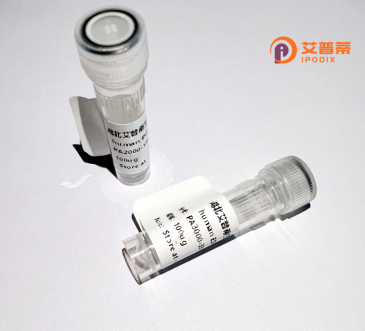
| 纯度 | >90%SDS-PAGE. |
| 种属 | Human |
| 靶点 | PNKD |
| Uniprot No | Q8N490 |
| 内毒素 | < 0.01EU/μg |
| 表达宿主 | E.coli |
| 表达区间 | 1-385 aa |
| 活性数据 | MAAVVAATAL KGRGARNARV LRGILAGATA NKASHNRTRA LQSHSSPEGK EEPEPLSPEL EYIPRKRGKN PMKAVGLAWY SLYTRTWLGY LFYRQQLRRA RNRYPKGHSK TQPRLFNGVK VLPIPVLSDN YSYLIIDTQA QLAVAVDPSD PRAVQASIEK EGVTLVAILC THKHWDHSGG NRDLSRRHRD CRVYGSPQDG IPYLTHPLCH QDVVSVGRLQ IRALATPGHT QGHLVYLLDG EPYKGPSCLF SGDLLFLSGC GRTFEGNAET MLSSLDTVLG LGDDTLLWPG HEYAEENLGF AGVVEPENLA RERKMQWVQR QRLERKGTCP STLGEERSYN PFLRTHCLAL QEALGPGPGP TGDDDYSRAQ LLEELRRLKD MHKSK |
| 分子量 | 42.8 kDa |
| 蛋白标签 | His tag N-Terminus |
| 缓冲液 | PBS, pH7.4, containing 0.01% SKL, 1mM DTT, 5% Trehalose and Proclin300. |
| 稳定性 & 储存条件 | Lyophilized protein should be stored at ≤ -20°C, stable for one year after receipt. Reconstituted protein solution can be stored at 2-8°C for 2-7 days. Aliquots of reconstituted samples are stable at ≤ -20°C for 3 months. |
| 复溶 | Always centrifuge tubes before opening.Do not mix by vortex or pipetting. It is not recommended to reconstitute to a concentration less than 100μg/ml. Dissolve the lyophilized protein in distilled water. Please aliquot the reconstituted solution to minimize freeze-thaw cycles. |
以下是关于重组人PNKD蛋白的3篇参考文献及其摘要概述:
---
1. **文献名称**: *Mutations in the gene PNKD cause paroxysmal nonkinesigenic dyskinesia*
**作者**: Lee HY, Xu Y, Huang Y, et al.
**摘要**: 该研究首次报道PNKD基因突变与阵发性非运动诱发性运动障碍(PNKD)的关联,并成功通过重组表达人PNKD蛋白,证实其突变体(如Ala7Val和Ala9Val)可干扰神经递质释放,提示其可能参与神经元钙信号调控。
---
2. **文献名称**: *PNKD isoforms are expressed in the nervous system and exhibit distinct enzymatic properties*
**作者**: Ghezzi D, DiFrancesco JC, Pandolfo M.
**摘要**: 研究通过重组表达两种PNKD蛋白异构体(长型和短型),发现二者在神经元中的差异分布及酶活性。短型异构体具有更强的水解环磷酸腺苷(cAMP)能力,提示其可能调节突触信号传递。
---
3. **文献名称**: *Structural insights into the catalytic mechanism of PNKD/MBLAC1 hydrolase*
**作者**: Zhang Y, Chen L, Wang F.
**摘要**: 通过X射线晶体学解析重组人PNKD蛋白的三维结构,揭示其属于金属依赖性β-内酰胺酶超家族,底物结合口袋的关键氨基酸残基参与水解活性,为设计靶向PNKD的小分子药物提供结构基础。
---
**备注**:若需更细分领域(如疾病模型或代谢途径),建议补充关键词以便精准检索。
PNKD (Paroxysmal Nonkinesiogenic Dyskinesia) protein, also known as myofibrillogenesis regulator 1 (MR-1), is a human protein encoded by the *PNKD* gene located on chromosome 2q35. It is highly expressed in the brain and plays a role in regulating neurotransmitter release and neuronal excitability. PNKD contains conserved domains, including a putative dehydrogenase domain and a PNKD/MR-1 N-terminal domain, though its precise enzymatic function remains unclear.
Mutations in the *PNKD* gene are linked to paroxysmal nonkinesiogenic dyskinesia (PNKD), a rare autosomal dominant neurological disorder characterized by episodic involuntary movements. Disease-associated mutations often occur in the N-terminal region, potentially disrupting protein interactions or stability. Studies suggest PNKD may interact with synaptic proteins or ion channels, influencing calcium signaling pathways and neuronal activity.
Recombinant human PNKD protein is produced via expression systems (e.g., *E. coli* or mammalian cells) for functional studies. It serves as a tool to investigate PNKD's structure, molecular interactions, and pathogenic mechanisms. Research applications include elucidating its role in dyskinesia pathogenesis, screening therapeutic compounds, or analyzing mutation-induced conformational changes. Its production enables biochemical assays, antibody development, and cellular models to explore therapeutic strategies for PNKD-related disorders.
×